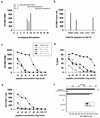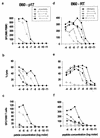Identification of dominant optimal HLA-B60- and HLA-B61-restricted cytotoxic T-lymphocyte (CTL) epitopes: rapid characterization of CTL responses by enzyme-linked immunospot assay
- PMID: 10954555
- PMCID: PMC116366
- DOI: 10.1128/jvi.74.18.8541-8549.2000
Identification of dominant optimal HLA-B60- and HLA-B61-restricted cytotoxic T-lymphocyte (CTL) epitopes: rapid characterization of CTL responses by enzyme-linked immunospot assay
Abstract
Human immunodeficiency virus type 1 (HIV-1)-specific cytotoxic T-lymphocyte (CTL) responses play a major role in the antiviral immune response, but the relative contribution of CTL responses restricted by different HLA class I molecules is less well defined. HLA-B60 or the related allele B61 is expressed in 10 to 20% of Caucasoid populations and is even more highly prevalent in Asian populations, but yet no CTL epitopes restricted by these alleles have been defined. Here we report the definition of five novel HLA-B60-restricted HIV-1-specific CTL epitopes, using peripheral blood mononuclear cells in enzyme-linked immunospot (Elispot) assays and using CTL clones and lines in cytolytic assays. The dominant HLA-B60-restricted epitope, Nef peptide KEKGGLEGL, was targeted by all eight subjects with B60 and also by both subjects with B61 studied. This study additionally establishes the utility of the Elispot assay as a more rapid and efficient method of defining novel CTL epitopes. This approach will help to define new CTL epitopes that may play an important role in the immune control of HIV-1.
Figures




References
-
- Arnett K L, Parham P. HLA class I nucleotide sequences. Tissue Antigens. 1995;46:217–257. - PubMed
-
- Bannai M, Tokunaga K, Lin L, Ogawa A, Fujisawa K, Juji T. HLA-B40, B18, B27, and B37 allele discrimination using group-specific amplification and SSCP method. Hum Immunol. 1996;46:107–113. - PubMed
-
- Borrow P, Lewicki H, Wei X, Horwitz M S, Peffer N, Meyers H, Nelson J A, Gairin J E, Hahn B H, Oldstone M B, Shaw G M. Antiviral pressure exerted by HIV-1-specific cytotoxic T lymphocytes (CTLs) during primary infection demonstrated by rapid selection of CTL escape virus. Nat Med. 1997;3:205–211. - PubMed
Publication types
MeSH terms
Substances
Grants and funding
LinkOut - more resources
Full Text Sources
Other Literature Sources
Research Materials

